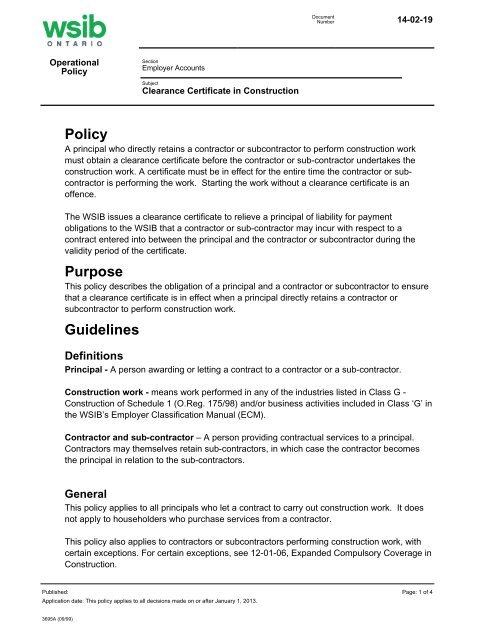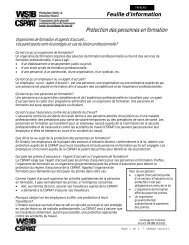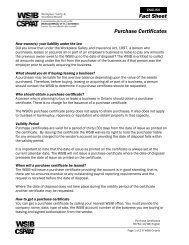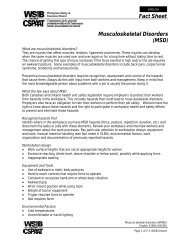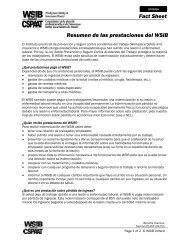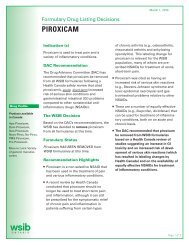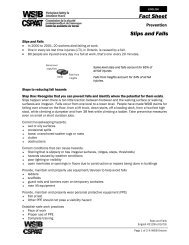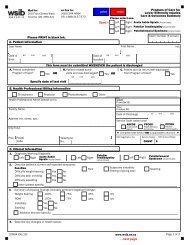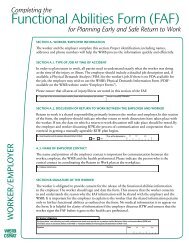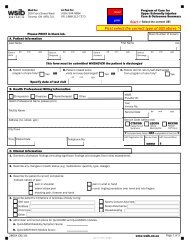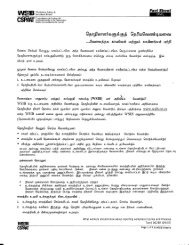Clearance Certificate in Construction - wsib
Clearance Certificate in Construction - wsib
Clearance Certificate in Construction - wsib
Create successful ePaper yourself
Turn your PDF publications into a flip-book with our unique Google optimized e-Paper software.
Document<br />
Number 14-02-19<br />
Operational<br />
Policy<br />
Section<br />
Employer Accounts<br />
Subject<br />
<strong>Clearance</strong> <strong>Certificate</strong> <strong>in</strong> <strong>Construction</strong><br />
Policy<br />
A pr<strong>in</strong>cipal who directly reta<strong>in</strong>s a contractor or subcontractor to perform construction work<br />
must obta<strong>in</strong> a clearance certificate before the contractor or sub-contractor undertakes the<br />
construction work. A certificate must be <strong>in</strong> effect for the entire time the contractor or subcontractor<br />
is perform<strong>in</strong>g the work. Start<strong>in</strong>g the work without a clearance certificate is an<br />
offence.<br />
The WSIB issues a clearance certificate to relieve a pr<strong>in</strong>cipal of liability for payment<br />
obligations to the WSIB that a contractor or sub-contractor may <strong>in</strong>cur with respect to a<br />
contract entered <strong>in</strong>to between the pr<strong>in</strong>cipal and the contractor or subcontractor dur<strong>in</strong>g the<br />
validity period of the certificate.<br />
Purpose<br />
This policy describes the obligation of a pr<strong>in</strong>cipal and a contractor or subcontractor to ensure<br />
that a clearance certificate is <strong>in</strong> effect when a pr<strong>in</strong>cipal directly reta<strong>in</strong>s a contractor or<br />
subcontractor to perform construction work.<br />
Guidel<strong>in</strong>es<br />
Def<strong>in</strong>itions<br />
Pr<strong>in</strong>cipal - A person award<strong>in</strong>g or lett<strong>in</strong>g a contract to a contractor or a sub-contractor.<br />
<strong>Construction</strong> work - means work performed <strong>in</strong> any of the <strong>in</strong>dustries listed <strong>in</strong> Class G -<br />
<strong>Construction</strong> of Schedule 1 (O.Reg. 175/98) and/or bus<strong>in</strong>ess activities <strong>in</strong>cluded <strong>in</strong> Class ‘G’ <strong>in</strong><br />
the WSIB’s Employer Classification Manual (ECM).<br />
Contractor and sub-contractor – A person provid<strong>in</strong>g contractual services to a pr<strong>in</strong>cipal.<br />
Contractors may themselves reta<strong>in</strong> sub-contractors, <strong>in</strong> which case the contractor becomes<br />
the pr<strong>in</strong>cipal <strong>in</strong> relation to the sub-contractors.<br />
General<br />
This policy applies to all pr<strong>in</strong>cipals who let a contract to carry out construction work. It does<br />
not apply to householders who purchase services from a contractor.<br />
This policy also applies to contractors or subcontractors perform<strong>in</strong>g construction work, with<br />
certa<strong>in</strong> exceptions. For certa<strong>in</strong> exceptions, see 12-01-06, Expanded Compulsory Coverage <strong>in</strong><br />
<strong>Construction</strong>.<br />
Published: Page: 1 of 4<br />
Application date: This policy applies to all decisions made on or after January 1, 2013.<br />
3695A (09/99)
Document<br />
Number 14-02-19<br />
Operational<br />
Policy<br />
Section<br />
Employer Accounts<br />
Subject<br />
<strong>Clearance</strong> <strong>Certificate</strong> <strong>in</strong> <strong>Construction</strong><br />
The bus<strong>in</strong>ess relationship between a pr<strong>in</strong>cipal and a contractor <strong>in</strong>cludes the relationship<br />
between a contractor (act<strong>in</strong>g as a pr<strong>in</strong>cipal) and a sub-contractor. In this policy therefore,<br />
unless otherwise <strong>in</strong>dicated, the term “contractor” <strong>in</strong>cludes “sub-contractor”.<br />
A clearance certificate confirms that the contractor or subcontractor is registered with the<br />
WSIB and is <strong>in</strong> good stand<strong>in</strong>g.<br />
Accounts <strong>in</strong> good stand<strong>in</strong>g<br />
A clearance certificate is issued if the follow<strong>in</strong>g requirements are met. If the contractor has<br />
more than one account, each account must meet these requirements before a certificate is<br />
issued for any of the accounts.<br />
•<br />
•<br />
•<br />
•<br />
•<br />
•<br />
the contractor has an open account with the WSIB<br />
the contractor has completed and provided all required registration <strong>in</strong>formation and<br />
documents<br />
the contractor’s declared bus<strong>in</strong>ess activities are classified <strong>in</strong> the proper classification<br />
units; see 14-01-01, The Classification Scheme<br />
the contractor has reported appropriate premiums based on actual or estimated <strong>in</strong>surable<br />
earn<strong>in</strong>gs for all past report<strong>in</strong>g periods<br />
all required Premium Remittance and Reconciliation forms are filed<br />
all premiums and other amounts ow<strong>in</strong>g to the WSIB are paid up-to-date at the time the<br />
clearance certificate is requested. In addition to premiums on <strong>in</strong>surable earn<strong>in</strong>gs, other<br />
amounts ow<strong>in</strong>g <strong>in</strong>clude <strong>in</strong>terest, service charges, experience rat<strong>in</strong>g surcharges and other<br />
non-compliance charges<br />
Advance payment<br />
Before a clearance is issued for a newly registered contractor, or to a pr<strong>in</strong>cipal for a newly<br />
registered contractor, the contractor must make an advance payment for the amount<br />
determ<strong>in</strong>ed by the WSIB.<br />
Pr<strong>in</strong>cipal’s liability<br />
By issu<strong>in</strong>g a clearance certificate, the WSIB waives its right to hold a pr<strong>in</strong>cipal liable for<br />
unpaid premiums and other amounts the contractor owes the WSIB, for the validity period of<br />
the certificate.<br />
Published: Page: 2 of 4<br />
Application date: This policy applies to all decisions made on or after January 1, 2013.<br />
3695A (09/99)
Document<br />
Number 14-02-19<br />
Operational<br />
Policy<br />
Section<br />
Employer Accounts<br />
Subject<br />
<strong>Clearance</strong> <strong>Certificate</strong> <strong>in</strong> <strong>Construction</strong><br />
Limits to liability<br />
If the contractor has payment obligations ow<strong>in</strong>g to the WSIB, the pr<strong>in</strong>cipal may be liable for<br />
the unpaid premiums and other outstand<strong>in</strong>g amounts, up to the value of the labour portion of<br />
the contract(s) between the contractor and the pr<strong>in</strong>cipal.<br />
Contractor’s obligations<br />
A contractor must meet its registration, report<strong>in</strong>g and payment obligations to have its account<br />
<strong>in</strong> good stand<strong>in</strong>g.<br />
A contractor may not perform construction work for a pr<strong>in</strong>cipal without a valid certificate of<br />
clearance <strong>in</strong> effect.<br />
Validity period<br />
A clearance certificate is valid for up to 90 calendar days, depend<strong>in</strong>g on the date that it is<br />
issued, and is renewable.<br />
Exceptions<br />
Contractor’s account not <strong>in</strong> good stand<strong>in</strong>g<br />
When a contractor’s account is not <strong>in</strong> good stand<strong>in</strong>g a clearance certificate may be issued if<br />
•<br />
•<br />
the pr<strong>in</strong>cipal pays the amount ow<strong>in</strong>g, as determ<strong>in</strong>ed by the WSIB, or<br />
an approved payment plan is <strong>in</strong> place and payments are made, as determ<strong>in</strong>ed by the<br />
WSIB. See 14-04-04, Collections Based on F<strong>in</strong>ancial Hardship.<br />
Contractor’s account closed<br />
Even though a contractor’s account is closed the contractor or the pr<strong>in</strong>cipal may request a<br />
clearance certificate throughout the time period of the contract. In these cases the WSIB may<br />
issue a letter reliev<strong>in</strong>g the pr<strong>in</strong>cipal of liability if<br />
•<br />
•<br />
the contractor owes no premiums and/or other amounts to the WSIB, or<br />
premiums and/or other amounts are ow<strong>in</strong>g; and the pr<strong>in</strong>cipal pays the amount due, up to<br />
the value of the premiums for the labour portion of the contract(s) between that pr<strong>in</strong>cipal<br />
and the contractor.<br />
If a clearance certificate is issued for an overdue account, or a letter waiv<strong>in</strong>g liability is issued<br />
for a closed account, the validity period is determ<strong>in</strong>ed by the WSIB tak<strong>in</strong>g <strong>in</strong>to account the<br />
circumstances of the case.<br />
Published: Page: 3 of 4<br />
Application date: This policy applies to all decisions made on or after January 1, 2013.<br />
3695A (09/99)
Document<br />
Number 14-02-19<br />
Operational<br />
Policy<br />
Section<br />
Employer Accounts<br />
Subject<br />
<strong>Clearance</strong> <strong>Certificate</strong> <strong>in</strong> <strong>Construction</strong><br />
Letter of credit<br />
A contractor is permitted to post a letter of credit represent<strong>in</strong>g a disputed amount be<strong>in</strong>g<br />
appealed. A clearance certificate is issued when the contractor has complied with all the<br />
requirements listed <strong>in</strong> “Accounts <strong>in</strong> good stand<strong>in</strong>g” and the letter of credit for the disputed<br />
amount is posted to the account. For more <strong>in</strong>formation, see 14-04-05, Alternative Payment<br />
Arrangements.<br />
Reta<strong>in</strong><strong>in</strong>g a clearance<br />
Pr<strong>in</strong>cipals and contractors must keep clearance certificates or copies of certificates for at least<br />
three years from the date they obta<strong>in</strong>ed them.<br />
Application date<br />
This policy applies to all decisions made on or after January 1, 2013.<br />
Policy review schedule<br />
This policy will be reviewed with<strong>in</strong> two years of the application date.<br />
Document history<br />
This is a new policy.<br />
References<br />
Legislative authority<br />
Workplace Safety and Insurance Act, 1997, as amended<br />
Section 141.1, 141.2<br />
M<strong>in</strong>ute<br />
Adm<strong>in</strong>istrative<br />
#2 , May 8, 2012, Page 494<br />
Published: Page: 4 of 4<br />
Application date: This policy applies to all decisions made on or after January 1, 2013.<br />
3695A (09/99)


